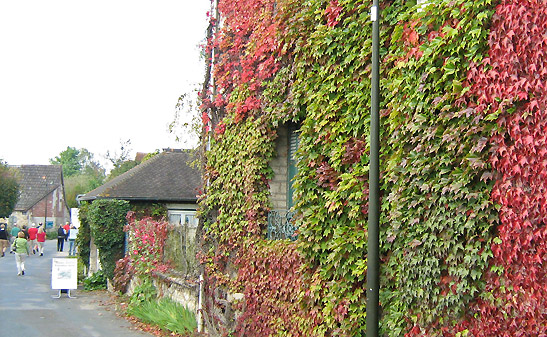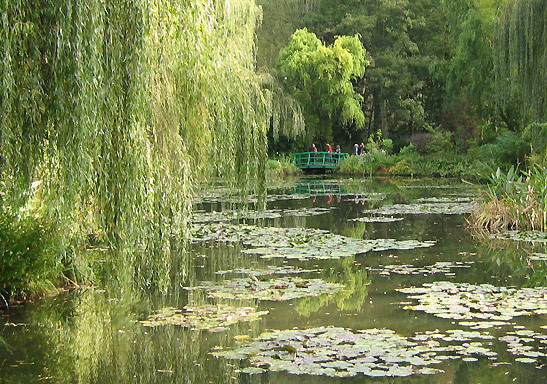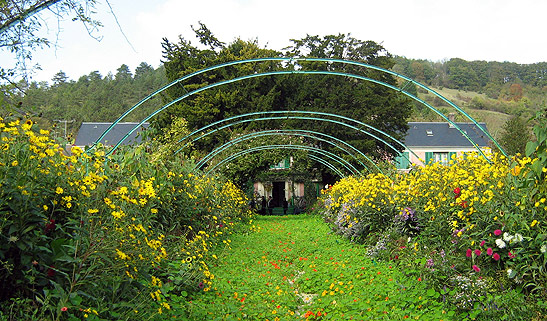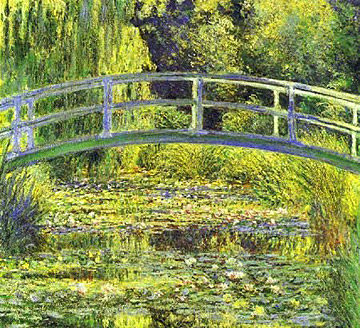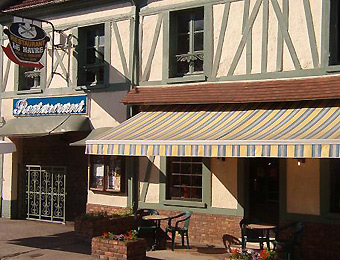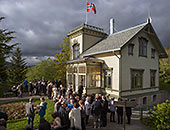 |
 |
|
 |

|
Monet’s Gardens
and
World Cup Rugby: What A Romantic Day Story and photos by Roger Fallihee
It was a warm October morning when we wandered out of our hotel to catch the morning train to Giverny and the home and gardens of Claude Monet, one of the fathers of French Impressionism. Both my wife and I had been inspired and moved by the iconic work of Monet, so to see the gardens, the water lilies, and the Japanese Bridge, the objects of so much of his art, would certainly be an exciting and romantic day. Little did we know that missing our train back to Paris would lead to a late afternoon of wine, cheese, fruit, bread, and World Cup Rugby, that would prove to be equally exciting and romantic. We arrived in Giverny at 11:00 am and immediately hopped onto a waiting shuttle bus that would take us the two miles to Monet’s home and gardens.
Once we dispensed with the 21st century ritual of slapping down the Visa card to buy tickets, we went through the gates and entered a world that was at once as magical, beautiful, and captivating as the collected works of Monet. Claude Monet (1840-1926) was the rarest of all artists: he was financially successful. Today his work has been reproduced into countless posters, calendars, and reproductions, making Monet one of the most famous, recognizable, and posthumously wealthy artists in history. One day in 1883, while riding through the village of Giverny, Monet gazed out the window and instantly fell in love with the light and the colors of this corner of his beloved French countryside. Monet and his companion Alice Hoschede, along with their combined eight children, rented a large house on three acres. Over the next few years they planted thousands of flowers and plants. In 1890 he had gained enough wealth to purchase the property. An inspired Monet hired workers to dig a large hole in the ground and divert a branch of the Epte River into the hole. The resulting pond and Japanese Bridge would forever change the course of art history.
Monet had a practical and businesslike approach to painting. After years of watching himself and his peers struggle to find the correct light and landscape to create art, Monet decided that the best way to resolve the problem would be to build and maintain his own environment. Monet, a practitioner of the “en plein air” (in the open air) style of painting, directed his staff of gardeners and laborers to create the world that he would paint for the next forty-three years. In addition to the Japanese Bridge and the water lily pond, Monet had in excess of 200,000 flowers planted. Half of these were perennials but the other half had to be replaced each spring.
Wandering around the grounds with my wife of two weeks (I knew her for thirty-three years, but these things take time) we were transported back to Monet’s wonderful world of light and color. It was amazing to sit where he sat, look at what he looked at, and imagine him painting some of the world’s finest and most works of art.
We walked in expecting a low-key, quiet restaurant, which I’m sure is normally the case. However, on this day, France was playing England in the semi-finals of the 2007 Rugby World Cup. The place was packed with boisterous, loudly cheering and booing, smoking and drinking, laughing and eventually crying locals. (Final score: England 14 – France 9).
Unlike American sports bars, with fifteen big screen
TV’s, chili dogs, pizza, and pitchers of Budweiser, Le Havre had
platters of local artisan cheese, slices of pears and apples, Duck Foie
Gras, skate wing fish with green beans, small baguettes, and a single
13” portable TV. The French didn’t need a 60” Plasma TV and plates filled with hot wings and potato skins. They had their camaraderie, their bread, cheese, and wine, a fierce love for their team, an equally fierce hatred for Team England, and in the end a strong spirit of “attendre jusqu'à la prochaine fois” (wait until next year). Romance can be found in the most expected and unexpected
places. The beauty and history of Monet’s gardens and the unexpected
thrill of watching Rugby World Cup and eating gourmet food with a room
full of emotionally charged French people, made us both realize that,
in the end, it’s not necessarily the events, but the time that
we spend together that creates the romance. And we did make it back
to Paris in time for the perfect ending to the perfect day. Love is
better the second time around. |
|
As you may (or may not!) know from reading my stuff on TBoy, I'm a WW2 aficionado, and several years ago on one of my many trips to Normandy, I stopped by Monet's home. I was transfixed from the second I walked into his garden, and felt as if I was part of one of his paintings. Your marvelous story captures the essence and magic of an equally marvleous and captivating house and garden, and it made me feel as if I were back there myslef. The hallmarks of any really great travel journalist is to be able to transport the reader to whatever he or she is reading, and make them feel as if THEY are seeing and doing what you, as the travel journalist, are describing. YOU have that talent in spades, and let me give you a British Hi Five and Super Bravo for a super story on this mesmerizing French destination. I hope it encourages many TBoy readers to go there. Again, congratulations! -- John, Rancho Palos Verdes, CA
Loved this article! You have such a strong, true voice -- reading you is like having a chat with you -- always a pleasure! -- Jamie, Edmonds, WA
|
|
| |||
This site is designed and maintained by WYNK Marketing. Send all technical issues to: support@wynkmarketing.com

|







